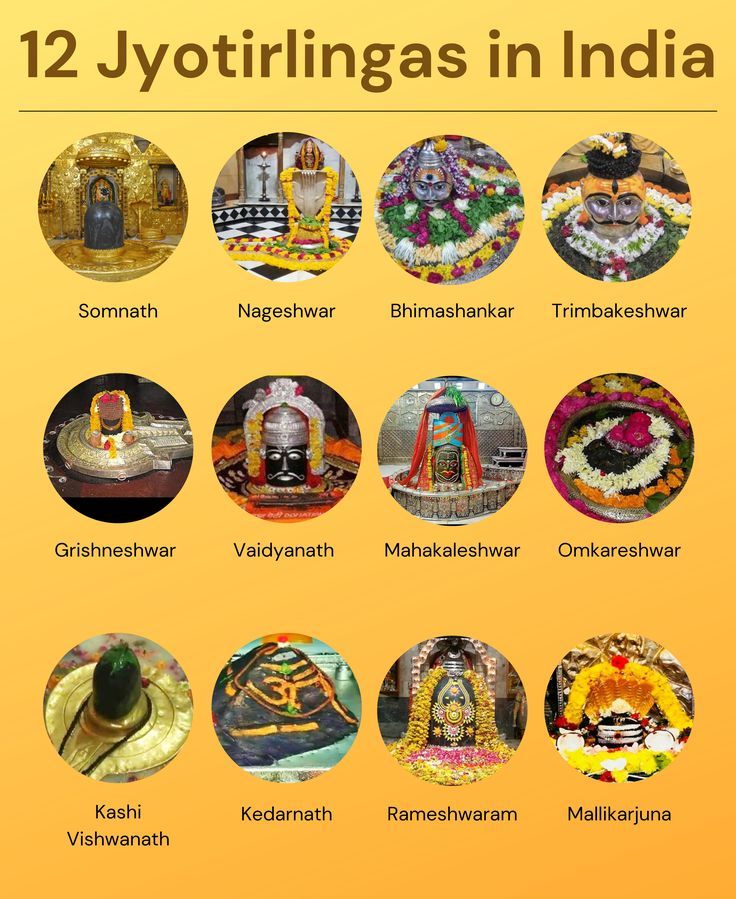The 12 Jyotirlingas are sacred shrines dedicated to Lord Shiva, one of the principal deities in Hinduism. Each Jyotirlinga represents a different form of Shiva and holds immense significance for devotees. The term “Jyotirlinga” comes from “Jyoti,” meaning light, and “linga,” meaning symbol or mark. Together, they signify the radiant form of Lord Shiva. This blog post will explore each of these revered sites, their locations, and the stories behind them.
1. Somnath Jyotirlinga
Located in Gujarat, Somnath is considered the first Jyotirlinga. It symbolizes the eternal nature of Shiva and has been rebuilt several times after being destroyed by invaders. The temple’s architecture is magnificent, and it attracts millions of pilgrims each year.
2. Mallikarjuna Jyotirlinga
Found in Andhra Pradesh, at Srisailam, Mallikarjuna is unique as it represents the union of Lord Shiva and Goddess Parvati. This temple is also one of the 18 Shakti Peethas, making it a significant site for both Shaivites and Shaktas.
3. Mahakaleshwar Jyotirlinga
Situated in Ujjain, Madhya Pradesh, Mahakaleshwar is famous for its Bhasma Aarti, a ritual performed with sacred ash. This Jyotirlinga is believed to be self-manifested (Swayambhu) and symbolizes the lord of time and death.
4. Omkareshwar Jyotirlinga
Omkareshwar is located on an island in the Narmada River, Madhya Pradesh. The temple here is shaped like the sacred sound “Om,” representing the essence of the universe. It is a place where devotees seek spiritual enlightenment.
5. Kedarnath Jyotirlinga
Nestled in the Himalayas, Kedarnath is one of the most visited Jyotirlingas, especially during summer months when it is accessible. The temple’s location amidst majestic mountains adds to its spiritual significance, symbolizing salvation and devotion.
6. Bhimashankar Jyotirlinga
Located near Pune in Maharashtra, Bhimashankar is surrounded by lush greenery and wildlife. It represents Shiva as the destroyer of evil and is also known for its scenic beauty and tranquility.
7. Kashi Vishwanath Jyotirlinga
In Varanasi, Uttar Pradesh, Kashi Vishwanath is considered one of the holiest places in India. It offers liberation (moksha) to those who visit, making it a vital pilgrimage site for Hindus.
8. Triambakeshwar Jyotirlinga
Triambakeshwar can be found near Nashik, Maharashtra. It is unique as it has three faces representing Brahma, Vishnu, and Maheshwara (Shiva). The temple is also located near the source of the Godavari River.
9. Vaidyanath Jyotirlinga
Vaidyanath is located at Deoghar in Jharkhand and Parli in Maharashtra. This site is associated with healing and curing ailments, making it an important destination for those seeking health-related blessings.
10. Nageshwar Jyotirlinga
Nageshwar can be found near Dwarka in Gujarat. It represents Lord Shiva as the protector from all fears and evils, making it a place where devotees seek refuge.
11. Rameshwaram Jyotirlinga
Situated at Rameswaram in Tamil Nadu, this temple holds great significance as it connects to the epic Ramayana. It symbolizes devotion and faith, attracting pilgrims who wish to pay homage to Lord Rama.
12. Ghrishneshwar Jyotirlinga
Ghrishneshwar is located near Ellora in Maharashtra and is known for its stunning architecture and rich history. It represents Lord Shiva as a deity who grants happiness and prosperity to his devotees.
Significance of Jyotirlingas
Each Jyotirlinga has its own unique story that highlights different aspects of Lord Shiva’s nature:
- Spiritual Connection: Visiting these sites allows devotees to connect deeply with their faith.
- Cultural Heritage: The temples are not just places of worship; they are also architectural marvels that reflect India’s rich cultural heritage.
- Pilgrimage Destination: Many Hindus embark on pilgrimages to visit all twelve Jyotirlingas as an act of devotion.
Conclusion
The 12 Jyotirlingas are more than just temples; they are symbols of faith, resilience, and spirituality that draw millions each year from around the world. Each site tells a story that connects devotees to their beliefs while offering a glimpse into India’s diverse cultural tapestry. Whether you seek spiritual enlightenment or simply wish to explore these magnificent structures, visiting these sacred sites can be a transformative experience.In summary, the journey through the twelve Jyotirlingas not only enriches one’s understanding of Hinduism but also provides an opportunity for reflection on life’s deeper meanings through devotion to Lord Shiva.
Frequently Asked Questions (FAQ) about the 12 Jyotirlingas
1. What are the Jyotirlingas?
Jyotirlingas are sacred shrines dedicated to Lord Shiva, representing his divine light and energy. The term “Jyoti” means light, and “linga” refers to a symbol of Shiva. There are 12 Jyotirlingas in India, each with its own significance and mythology.
2. Why are there 12 Jyotirlingas?
The number 12 is significant in Hinduism, representing completeness and the cycle of time. Each Jyotirlinga symbolizes a different aspect of Lord Shiva, allowing devotees to connect with him in various forms.
3. Where are the 12 Jyotirlingas located?
The 12 Jyotirlingas are spread across India in the following locations:Somnath – Gujarat
Mallikarjuna – Andhra Pradesh
Mahakaleshwar – Madhya Pradesh
Omkareshwar – Madhya Pradesh
Kedarnath – Uttarakhand
Bhimashankar – Maharashtra
Kashi Vishwanath – Uttar Pradesh
Triambakeshwar – Maharashtra
Vaidyanath – Jharkhand/Maharashtra
Nageshwar – Gujarat
Rameshwaram – Tamil Nadu
Ghrishneshwar – Maharashtra
4. What is the significance of visiting Jyotirlingas?
Visiting Jyotirlingas is considered a sacred pilgrimage that brings spiritual benefits, blessings, and purification to devotees. Many believe that visiting all twelve can lead to liberation (moksha) and fulfillment of wishes.
5. Are the Jyotirlingas open to all visitors?
Yes, the Jyotirlingas are open to all devotees, regardless of their background or beliefs. However, visitors are expected to follow certain customs and rituals while at the temples.
6. What is the best time to visit the Jyotirlingas?
The best time to visit most Jyotirlingas is during the cooler months, typically from October to March, when weather conditions are more favorable for travel and pilgrimage.
7. What rituals are performed at the Jyotirlingas?
Common rituals include offering prayers (puja), lighting lamps (diyas), performing aarti (a devotional song), and making offerings of flowers and food. Each temple may have specific rituals unique to its traditions.
8. Can I visit all 12 Jyotirlingas in one trip?
While it is possible to plan a trip to visit all 12 Jyotirlingas, it requires careful planning due to their geographical spread across India. Many pilgrims choose to visit a few at a time or focus on specific ones based on their personal significance.
9. Are there any legends associated with each Jyotirlinga?
Yes, each Jyotirlinga has its own legend or story that explains its origin and significance, often involving ancient texts like the Shiva Purana or local folklore that highlights Lord Shiva’s divine nature.
10. How can I prepare for a pilgrimage to the Jyotirlingas?
To prepare for a pilgrimage:Research each Jyotirlinga and its rituals.
Plan your travel itinerary based on distance and accessibility.
Carry necessary items like offerings, comfortable clothing, and essentials for your journey.
Be respectful of local customs and traditions when visiting temples




